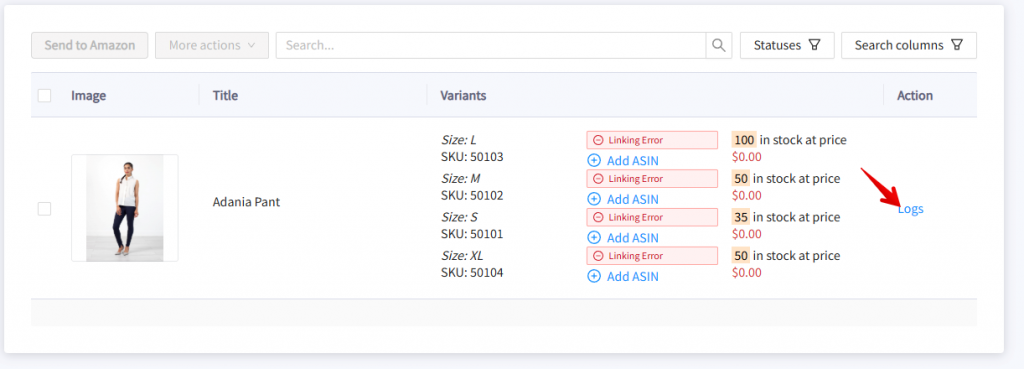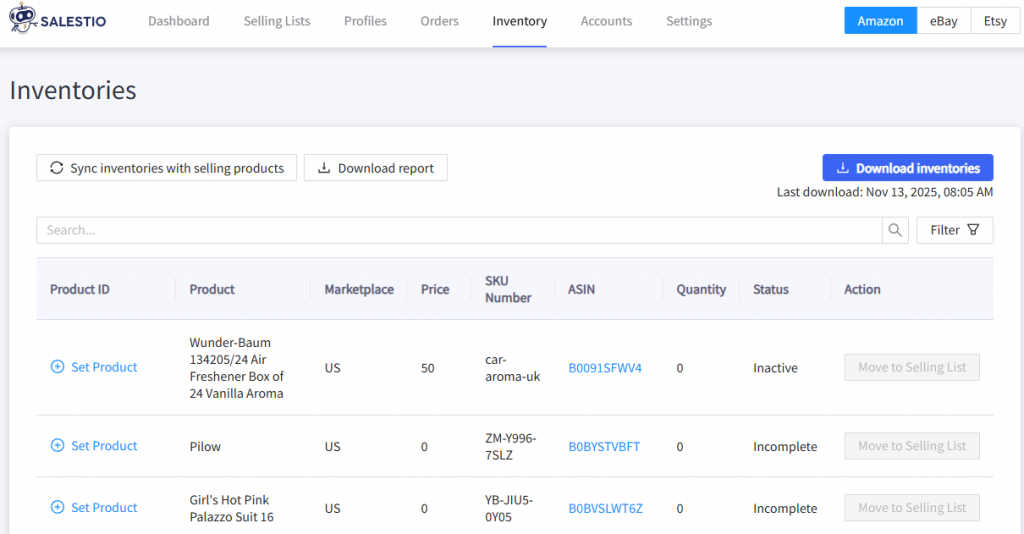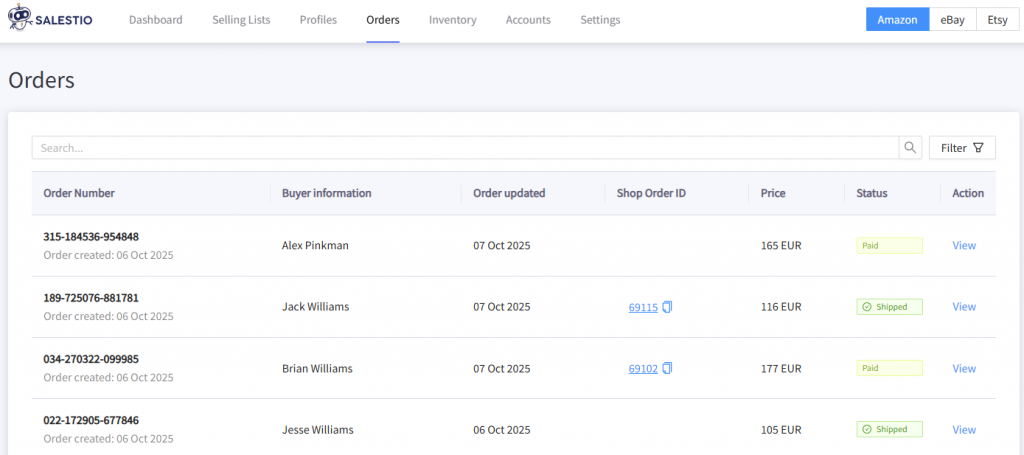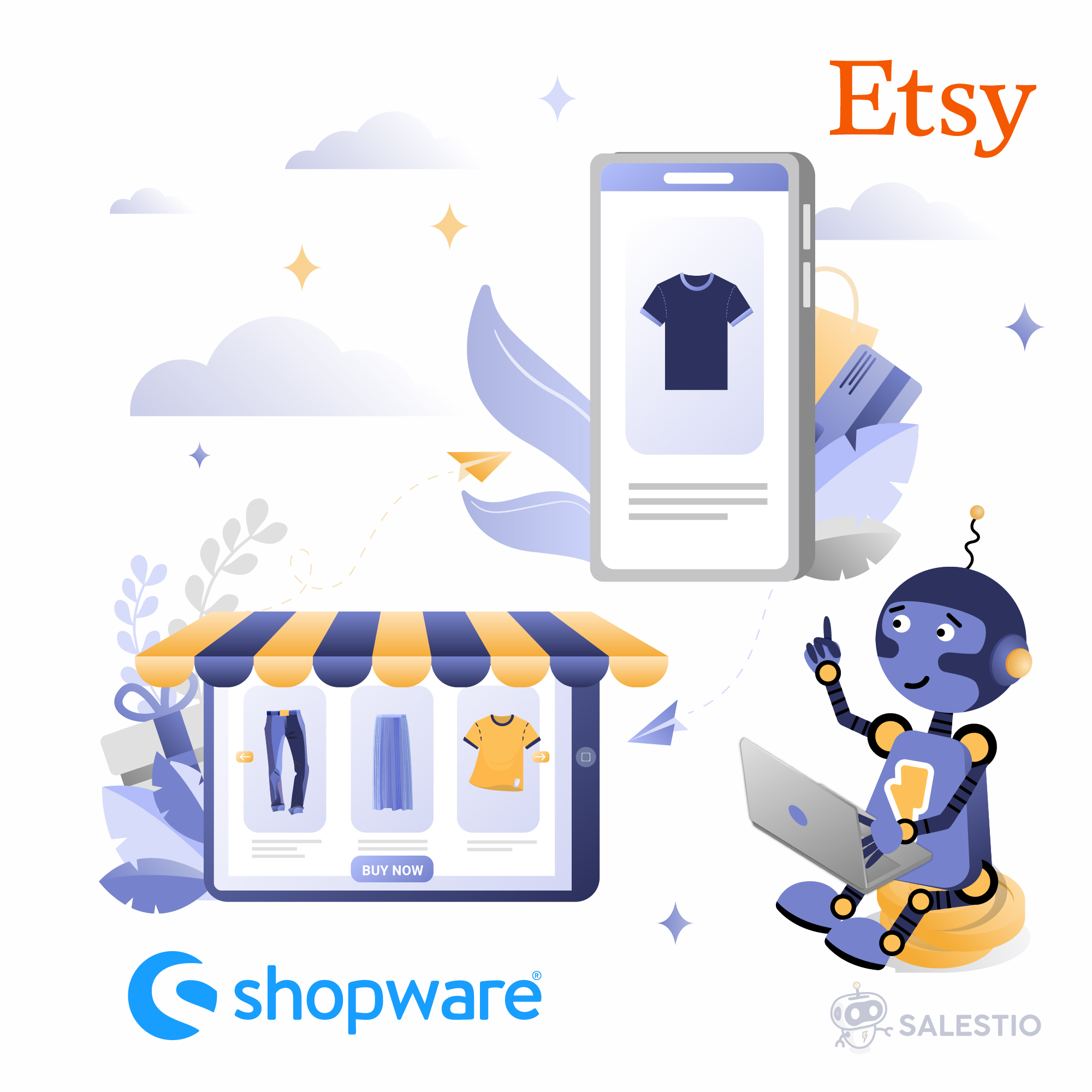14 Nov'25

Salestio serves as a means to connect your Shopware store to Amazon, eBay, and Etsy. In this article, we will explore the main features that help keep your marketplace listings in sync with the Shopware store.
Send the Shopware catalog to marketplaces
Salestio can send the items from your Shopware store to marketplaces of your choice. The listings can be published with the same variations, pictures, and product information, just like they are currently in the store. Below are the general steps to publish the items:
Connect a Seller account
Adding the seller account is the first step of any connection process. Go to the Accounts tab and click “Add Account’ to fill in the details and log in to the marketplace account.
Configure a Creation Profile
Here, you can specify which marketplace category should be used to publish the items, along with the product specifics like materials, style, department, and more. This is an optional step if you are sending products to Amazon (for items that are already in the Amazon catalog). Creation Profiles are always required for publishing on Etsy and eBay.

Salestio supports custom fields from your Shopware store. If you have them configured for the relevant product specifics, select them in the corresponding fields of the Creation Profile. Salestio will dynamically use the details from custom fields to publish the items.
Read more in the guide for custom fields (examples are shown from a BigCommerce store, but Salestio features are the same for Shopware).
Add a Global Profile
In the Global Profile, you can configure price and stock syncing rules. Salestio features a default profile from the start, which is used to send prices and stock levels exactly as they are in Shopware. You can use the default profile or configure an additional one to customize the listings.
Global Profiles can use different modes for syncing. For example, you can limit the marketplace quantity using the Buffer QTY mode or set a fixed quantity in Custom mode. For price, you can set a simple ratio to increase or decrease the original price in the listings or use a complex ruleset in a Price template. Check the additional articles for tips on price and stock sync.
Add Amazon/Ebay Profile
Amazon/Ebay Profiles hold the settings specific to the marketplace. Here, you can enable the Creation Profile from earlier steps, add shipping details, or item condition.
For eBay, you can specify the listing type here: fixed price or auction. If you have a GTIN exemption for your Seller Central account, enable the option in this profile.
Add a Description template
Salestio creates a default Description template, which copies the product descriptions to marketplace listings as they are in Shopware. Instead, you can add another template to customize how the descriptions should look. Here, you can add more details to it, use CSS formatting (only supported by eBay), or completely replace it with custom text and data from Shopware custom fields.

You can customize the product descriptions in Salestio > Profiles > Description template.
Full article: Description templates
Create a Selling List
To create a Selling List, go to Salestio > Selling Lists > Add Selling List.
This list holds the selling items, and you can manage them or check the status from here. If you added any custom Global Profiles, Amazon/Ebay Profiles, or Description templates, make sure to select them here during configuration.
Send products and check the results
Use the action buttons at the top to add products to the Selling List by adding individual items or categories (Product mode). In Category mode, items are added automatically, and the manual options are disabled.
Select the products and click the “Send” action to start publishing:

The process of publishing the item can take a few minutes, depending on the marketplace. After this is done, the status of the item will change to Linked. If you see an error status, check the item logs to find out what happened:

Try to resolve the error and send the item again. Check the solutions for common errors in dedicated articles for Amazon, eBay, and Etsy.
Connect to existing marketplace listings
If you have been actively selling on some of the marketplaces and now want to connect Shopware products to your other inventories, Salestio has an easy way to do so.
Connect the inventories
The product list from the connected marketplaces is downloaded to the Inventory tab in Salestio. Here you can find the products that have been listed earlier. To get the latest product list, click “Download inventories” and select your marketplace account.

To connect the items, click “Sync inventories with selling products”. This will have two effects:
- For items that are not added to any Selling Lists, the app will put them into an automatic one called “Migrated…” If you added some of the items to a Selling List previously, they will remain in the same place.
- All items that have not been connected yet will be changed to the Linked status.
The sync happens based on the SKU match between Shopware and the marketplace items. If your SKUs do not match, set up an SKU mapping.
At this stage, you can verify the product connection using the Synchronization report.
Update the connected items
We suggest performing an initial sync after the items are Linked. Go to your Selling List, select the items, and run the update action (“Update Price & QTY” for Etsy or Amazon, “Revise Quick” for eBay).
Now that the items are Linked, Salestio will keep scanning the Shopware store for changes and sync quantity and price to the marketplace automatically.
Synchronize orders
Salestio allows managing orders from multiple platforms in a single Shopware store. After you connect a seller account, new orders will start appearing automatically. You can find all of them in the Orders tab inside the app.
Full article on order sync: Processing Amazon, eBay, and Etsy orders in Salestio
The article takes examples from BigCommerce, and the same features work in Shopware.

Order import
Salestio will create the imported orders in Shopware, which mirror your marketplace store. To create a Shopware order, the app uses the item SKU to find a match between platforms and link the correct items.
To import and create the order in Shopware, it has to be paid on the marketplace first. Salestio also adds additional information, such as marketplace order ID, or customization in the Notes section.
Updating fulfillment for orders
Salestio synchronizes the fulfillment information for the imported orders automatically. You can handle the imported marketplace orders as regular ones and fulfill them in Shopware manually or use a third-party fulfillment app.
Then sync works both ways:
- Adding fulfillment to the Shopware order will transfer the shipping info and tracking number to the marketplace.
- Fulfilling the order directly from the seller account will update the Shopware status.
Salestio offers a wide set of features to help sellers keep track of multiple storefronts in one place. Start a Free 30-Day Trial of Salestio by getting the app from the Shopware Store.





